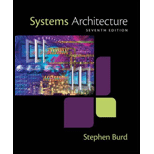
Systems Architecture
7th Edition
ISBN: 9781305080195
Author: Stephen D. Burd
Publisher: Cengage Learning
expand_more
expand_more
format_list_bulleted
Textbook Question
Chapter 3, Problem 30VE
A(n) ____________ is one instance or variable of a class.
Expert Solution & Answer
Trending nowThis is a popular solution!

Students have asked these similar questions
Dijkstra's Algorithm (part 1). Consider the network shown below, and Dijkstra’s link-state algorithm. Here, we are interested in computing the least cost path from node E (note: the start node here is E) to all other nodes using Dijkstra's algorithm. Using the algorithm statement used in the textbook and its visual representation, complete the "Step 0" row in the table below showing the link state algorithm’s execution by matching the table entries (i), (ii), (iii), and (iv) with their values. Write down your final [correct] answer, as you‘ll need it for the next question.
4. |z + 5 - 5i| = 7
14.
dz,
C: |z❘
C: |z❘ = 0.6
ze² - 2iz
H
Chapter 3 Solutions
Systems Architecture
Ch. 3 - Prob. 1VECh. 3 - Prob. 2VECh. 3 - A(n) __________ is an integer stored in double the...Ch. 3 - Prob. 4VECh. 3 - Assembly (machine) language programs for most...Ch. 3 - Prob. 6VECh. 3 - Prob. 7VECh. 3 - Prob. 8VECh. 3 - Prob. 9VECh. 3 - A(n) __________ is an array of characters.
Ch. 3 - Most Intel CPUs use the __________, in which each...Ch. 3 - Prob. 12VECh. 3 - A(n) __________ contains 8 __________.Ch. 3 - Prob. 14VECh. 3 - The result of adding, subtracting, or multiplying...Ch. 3 - Prob. 16VECh. 3 - Prob. 17VECh. 3 - Prob. 18VECh. 3 - Prob. 19VECh. 3 - Prob. 20VECh. 3 - Prob. 21VECh. 3 - Prob. 22VECh. 3 - ___________ occurs when the result of an...Ch. 3 - In a CPU, _______ arithmetic generally is easier...Ch. 3 - In the ________, memory addresses consist of a...Ch. 3 - Prob. 26VECh. 3 - Data represented in ________ is transmitted...Ch. 3 - Prob. 28VECh. 3 - Prob. 29VECh. 3 - A(n) ____________ is one instance or variable of a...Ch. 3 - Prob. 1RQCh. 3 - Why is binary data representation and signaling...Ch. 3 - Prob. 3RQCh. 3 - Prob. 4RQCh. 3 - Prob. 5RQCh. 3 - Prob. 6RQCh. 3 - Prob. 7RQCh. 3 - Why doesnt a CPU evaluate the expression 'A' = 'a'...Ch. 3 - Prob. 9RQCh. 3 - What primitive data types can normally be...Ch. 3 - Prob. 11RQCh. 3 - How is an array stored in main memory? How is a...Ch. 3 - Prob. 14RQCh. 3 - Prob. 1PECh. 3 - Prob. 2PECh. 3 - Prob. 4PECh. 3 - Prob. 5PECh. 3 - Prob. 6PECh. 3 - Prob. 1RPCh. 3 - Prob. 2RPCh. 3 - Prob. 3RP
Knowledge Booster
Learn more about
Need a deep-dive on the concept behind this application? Look no further. Learn more about this topic, computer-science and related others by exploring similar questions and additional content below.Similar questions
arrow_back_ios
SEE MORE QUESTIONS
arrow_forward_ios
Recommended textbooks for you
 C++ for Engineers and ScientistsComputer ScienceISBN:9781133187844Author:Bronson, Gary J.Publisher:Course Technology Ptr
C++ for Engineers and ScientistsComputer ScienceISBN:9781133187844Author:Bronson, Gary J.Publisher:Course Technology Ptr C++ Programming: From Problem Analysis to Program...Computer ScienceISBN:9781337102087Author:D. S. MalikPublisher:Cengage Learning
C++ Programming: From Problem Analysis to Program...Computer ScienceISBN:9781337102087Author:D. S. MalikPublisher:Cengage Learning Systems ArchitectureComputer ScienceISBN:9781305080195Author:Stephen D. BurdPublisher:Cengage Learning
Systems ArchitectureComputer ScienceISBN:9781305080195Author:Stephen D. BurdPublisher:Cengage Learning Microsoft Visual C#Computer ScienceISBN:9781337102100Author:Joyce, Farrell.Publisher:Cengage Learning,
Microsoft Visual C#Computer ScienceISBN:9781337102100Author:Joyce, Farrell.Publisher:Cengage Learning, EBK JAVA PROGRAMMINGComputer ScienceISBN:9781337671385Author:FARRELLPublisher:CENGAGE LEARNING - CONSIGNMENTProgramming Logic & Design ComprehensiveComputer ScienceISBN:9781337669405Author:FARRELLPublisher:Cengage
EBK JAVA PROGRAMMINGComputer ScienceISBN:9781337671385Author:FARRELLPublisher:CENGAGE LEARNING - CONSIGNMENTProgramming Logic & Design ComprehensiveComputer ScienceISBN:9781337669405Author:FARRELLPublisher:Cengage

C++ for Engineers and Scientists
Computer Science
ISBN:9781133187844
Author:Bronson, Gary J.
Publisher:Course Technology Ptr

C++ Programming: From Problem Analysis to Program...
Computer Science
ISBN:9781337102087
Author:D. S. Malik
Publisher:Cengage Learning

Systems Architecture
Computer Science
ISBN:9781305080195
Author:Stephen D. Burd
Publisher:Cengage Learning

Microsoft Visual C#
Computer Science
ISBN:9781337102100
Author:Joyce, Farrell.
Publisher:Cengage Learning,

EBK JAVA PROGRAMMING
Computer Science
ISBN:9781337671385
Author:FARRELL
Publisher:CENGAGE LEARNING - CONSIGNMENT

Programming Logic & Design Comprehensive
Computer Science
ISBN:9781337669405
Author:FARRELL
Publisher:Cengage
C++ Data Members; Author: CppNuts;https://www.youtube.com/watch?v=StlsYRNnWaE;License: Standard YouTube License, CC-BY